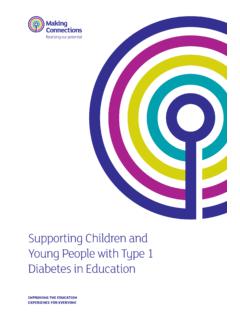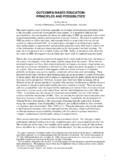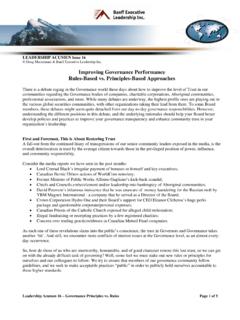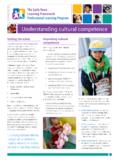Transcription of WHO Service Delivery Seminar Series DRAFT …
1 WHO Service Delivery Seminar Series DRAFT technical Brief No. 2, 3 July 2008 ESSENTIAL HEALTH PACKAGES: WHAT ARE THEY FOR? WHAT DO THEY CHANGE? Main messages This technical Brief is intended as a practical aid for people involved in discussions about Essential Health Packages. This is not a new topic, but there are many different interpretations and expectations of what an EHP can deliver. This Brief focuses primarily on experience with implementation, rather than on design methods. The following key messages can be drawn from the literature. Essential health packages aim to concentrate scarce resources on interventions which provide the best 'value for money'. By doing this, EHPs are often expected to achieve multiple goals: improved efficiency; equity; political empowerment, accountability, and altogether more effective care.
2 EHPs are intended to be a guaranteed minimum. An EHP in a low-income country consists of a limited list of public health and clinical interventions which will be provided at primary and/or secondary level care. In contrast, in richer countries packages are often described according to what they exclude. There are also 'partial packages' for particular disease or demographic groups. Essential health packages can enhance equity. However, if an EHP is to be universal, or a safety net for the poorest, there must be additional deliberate efforts to improve access. Private as well as public providers may need to be involved. It is important to understand the context in which a particular EHP is being discussed.
3 Some packages are aspirational - and describe what an EHP should eventually look like. Others are seen as a short term planning tool, and linked more directly to affordability. Implementing an EHP is not just a technical exercise. Political and institutional processes need to be engaged, because successful implementation involves dialogue on purpose and design; decisions on financing and Delivery arrangements, and adaptation over time. Without adequate national ownership, an EHP is unlikely to be implemented - no matter how popular it is with donors. Essential health packages are not a solution for weak management. Implementation has implications for budget allocations, essential medicines lists; the distribution and training of health workers and information systems.
4 The Brief ends with a list of questions to ask when embarking on EHP work. DRAFT 4, June 30, 2 1 Introduction Essential Health Packages (EHPs) are often promoted as an effective and efficient way of improving health Service Delivery . There is a recent resurgence in talk about packages, especially at country level, but with many different interpretations and expectations of what an EHP can deliver. Having defined the term, this technical Brief looks at the various reasons for promoting EHPs and their links with wider health sector issues. EHP design issues are outlined and alternatives to EHPs discussed. The Brief then moves on to explore implementation experience with the Delivery of EHPs, illustrating points with country examples.
5 This Brief does not look in detail at the content of specific EHPs. References are provided for readers who want to explore the subject in more depth. What is an EHP? An Essential Health Package in a low-income country consists of a limited list of public health and clinical services which will be provided at primary and/or secondary care level. In contrast, in richer countries, packages are often described according to what they EHPs obviously include different interventions in different countries reflecting variation in economic, epidemiological and social conditions. Box 1 shows the structure of Ethiopia s package, which is broadly typical of a low-income country. There are also partial EHPs for particular demographic or disease groups examples are EHPs for HIV/AIDS prevention, treatment and care; for mental health; and for maternal, newborn and child health interventions.
6 A package is not necessarily equivalent to a programme: the Integrated Management of Childhood Illness (IMCI) package is a good example in which an agreed set of priority interventions for child survival are implemented by several programmes (see box x). EHPs are intended to be a guaranteed minimum some clients will have needs which cannot be met by the EHP. With an EHP, the human skills, drugs, equipment and other resources required to deal with interventions within the package should be available. An EHP does not mean that clients with other health problems need to be turned away from health facilities but there is no guarantee that resources will be available to deal with their particular needs.
7 Box 1 Ethiopia s Essential Health services Package For each of the following broad categories, there are specific interventions to be provided at the health post, health centre and district hospital levels: Family health: ante-natal care; Delivery and newborn care; post-natal care; family planning; child health Integrated Management of Childhood Illness (IMCI); growth monitoring and essential nutrition actions; immunization; adolescent reproductive health Communicable diseases: TB and leprosy; HIV/AIDS and sexually transmitted infections; epidemic 1 Several variations of the term 'Essential Health Package' exist, generally using the terms basic, minimum, health care, services or benefit package.
8 For the purposes of this Brief, these terms are taken to all mean the same. DRAFT 4, June 30, 2 2diseases (including malaria surveillance); rabies Basic curative care and treatment of major chronic conditions Hygiene and environmental health ( this excludes the provision of mass sanitation and water supplies, which is the responsibility of a different sector) Health education and communication Essential Health Packages are generally developed using some combination of cost-effectiveness analysis and other technical , political and social considerations. The aim is to concentrate scarce resources on the services which provide the best 'value for money'. EHPs: recent history During the late 1970s and 1980s, Essential Health Packages were one aspect of the debate on the merits of a limited package of interventions versus the notion of comprehensive primary health care.
9 EHPs took centre-stage in the debate when the 1993 World Development Report posed a practical question how should governments in low-income countries spend their very limited health budgets? Using epidemiological and costing data, the Report argued that governments should radically shift their health expenditure towards spending on a minimum package of essential public health and clinical services . The Report of the Commission on Macroeconomics and Health (2001) and the 2006 Disease Control Priorities Project subsequently reinforced the importance of packages. Since the 1993 World Development Report, many middle and low-income countries have adapted the Essential Package idea to their own situations.
10 In some countries this has led to implementation. In others it is more a statement of principle. Interest in packages is not confined to one particular continent there are examples from Africa, Asia, Europe and South America. Box 2 The Minimum Package in Uganda a health planner's perspective The Declaration of Alma Ata in 1978 influenced the Ugandan Ministry of Health s subsequent five-year plans - their scope broadened from clinical services alone to the full primary health care package. However, funds were short and debate about a more limited package soon began - though the cost-effectiveness debate did not really influence discussions until the 1990s. In the 1990s, Uganda piloted a Minimum Health Care Package (MHCP).
















